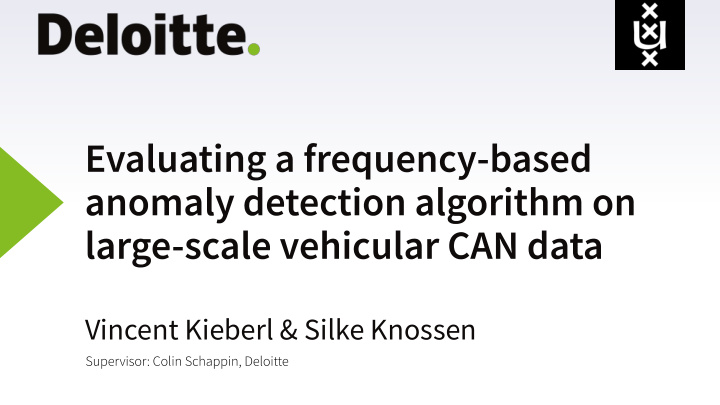



Vincent Kieberl & Silke Knossen
Central control unit 3 control units Bus system Source: Volkswagen AG, Data Exchange on the CAN bus I
The CAN bus Controller Area Network (CAN) ▸ Interconnects Electronic Control Units ▸ Source: Silke (ECUs) Bus system, broadcast ▸ CAN IDs for identification ▸ Read out through OBD-2 port (On-Board ▸ Diagnostics) Only standardized in OSI layers 1 & 2 ▸
Hacking a car using CAN Miller & Valasek’s Jeep hack ▸ Inserting, modifying, or deleting frames ▸ Every ECU has one specific frequency ▸ Frequency changes when adding/removing frames ▸
Taylor et al. 2015 Frequency-based anomaly detection ▸ Inter-packet time (interval) best feature ▸ Only used insertion attacks ▸
Schappin 2017 Different types of attacks: ▸ Fabrication attack: adding CAN messages ▹ Suspension attack: deleting CAN messages ▹ Masquerade attack: modifying CAN messages by adding them ▹ with ID and frequency of another ECU
Schappin 2017 Robust Covariance Estimator (RCE) ▸ Split CAN IDs into 3 groups with 3 separate classifiers: fast/medium/slow ▸ Data from 2011 Dodge Ram, 4.5 minutes in total, of which 30 seconds test data ▸ Data may not resemble real-world situations ▸
To what extent does the amount of training data influence the performance of the model based on the Robust Covariance Estimator (RCE) as proposed by [1] ?
How can we collect a What are the What is the influence of ▸ ▸ ▸ dataset from a real differences in data the amount of training vehicle that contains characteristics in data data on the performance over 40 minutes of CAN from an Audi and a of the RCE on fabrication, data with microsecond Ford vehicle? suspension, and accuracy? masquerade attacks?
Data acquisition PCAN USB FD connected to OBD2 port ▸ Tried on six cars of which two were ▸ successful Audi A4 2006 ▹ Ford Fiesta 2017 ▹ Min. 70 minutes of data ▸
The data Audi A4 (2006) Ford Fiesta (2017) ▸ ▸ 31 different CAN IDs 51 different CAN IDs ▹ ▹ Interval range 10ms - 1s Interval range 10ms - 10s ▹ ▹ All IDs throughout whole Two IDs only present in the first 5 ▹ ▹ dataset minutes
The RCE algorithm One-class classification algorithm ▸ Three classifiers for different interval ranges ▸ ID 1 ... ID n Preprocessed data ▸ mean mean ... Window 1 interval interval Three matrices for the interval ranges ▹ ... ... ... ... Classify data per window ▸ mean mean ... Window n interval interval
Experiments Different sizes of training sets ▸ 2; 5; 10; 20; 30; 45 minutes ▹ Simulating attacks by altering the testsets ▸ Fabrication, suspension, masquerade ▹ Different attack sizes per attack ▸ Small, medium, and large attacks ▹ 1 frame; 25 frames; ⅓ of all frames ▹
Able to obtain CAN traffic with microseconds timestamps ▸ Different data for different vehicle models ▸ Amount of training data does not have significant influence ▸ Depends on attack and CAN ID ▹
Limitations & future work Not all CAN IDs tested ▸ Only attack information is a time frame ▸ Non-recurring CAN frames ▸ Vehicle model specific ▸ Algorithm does not utilize CAN data field ▸ Proof of concept needs to work on input stream of data ▸
Recommend
More recommend